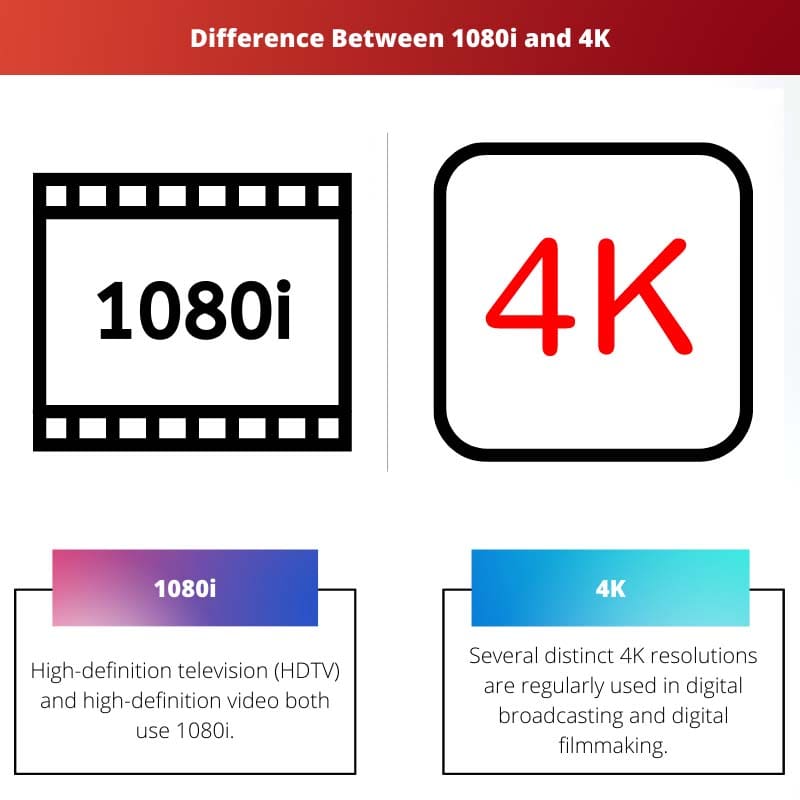The number of pixels grouped or sorted by width and height on a screen or picture is referred to as the resolution.1080i and 4k represent the number of pixels in a picture.
Key Takeaways
- 1080i is an interlaced video format with a resolution of 1920×1080 pixels, while 4K is a progressive format offering 3840×2160 pixels.
- 4K provides a sharper, more detailed image than 1080i due to its higher resolution.
- 4K televisions and content are more expensive than their 1080i counterparts but offer superior image quality.
1080i vs 4K
The difference between 1080i and 4K is that 4K signifies a resolution of 3840 x 2160 pixels, whereas 1080i signifies a resolution of 1920×1080 pixels. 4K resolution is four times that of 1080i. A 4K resolution provides a much better viewing experience than compared to a 1080i resolution due to the higher pixel count.

High-definition television (HDTV) and high-definition video both use 1080i. “1080” refers to the number of vertical lines on the screen. The “i” in 1080i stands for interlaced, which means they are painted on the screen in two passes of 540 lines each.
Several distinct 4K resolutions are regularly used in digital broadcasting and digital filmmaking. The prevalent 4K standard in television and consumer media is 3840 x 2160 (4K UHD), although the cinema projection business utilises 4096 x 2160 (DCI 4K).
Comparison Table
| Parameters of comparison | 1080i | 4K |
|---|---|---|
| Meaning | Having 1080 vertical lines on the screen | Having 3840 horizontal lines on the screen |
| Total pixels | More than 2 million | More than 8 million |
| Full form | i stands for interlaced | 4K stands for 4 X 1080p |
| Video/Image quality | Lower quality | Higher quality |
| Preferred video type | Preferred for slow-motion videos | Preferred for all types of videos |
| Marketing terms | Full HD, FHD | 2160p, Ultra HD, UHD |
What is 1080i?
1080i (Full HD) is a progressive scan with 1080 vertical and 1920 horizontal lines of pixels. No image quality losses are owing to the interlacing of picture frames as the picture is gradually scanned, and the picture clarity is significantly superior to that of lower picture resolutions like 720p and 480p.
Television broadcasts, Blu-ray Discs, cell phones, Internet content such as YouTube videos and Netflix TV episodes and movies, consumer-grade televisions and projectors, computer displays, and video gaming consoles are all examples of 1080i applications.
Still and moving photos at 1080i quality may be captured with small camcorders, cell phones, and digital cameras.
“i” stands for interlaced. Interlacing video is a technique for doubling the perceived frame rate of a video display without utilising any extra bandwidth.
When compared to non-interlaced footage, this practically doubles the temporal resolution. Interlaced signals necessitate a display that can display the separate fields in a sequential order natively.

What is 4K?
Depending on the TV manufacturer, 4K is sometimes known as Ultra-HD or UHD.
However, the vast majority of people think that the 4K bit is made up of 2,160 horizontal lines and 4,096 vertical lines of pixels.
Technically, UHD refers to an image with 3840 horizontal lines and 2160 vertical lines, or 3840 x 2160 pixels. Although it’s close, it’s not quite there, yet that doesn’t stop several manufacturers from labelling their TVs as 4K.
TVs, I believe that rather than all of us upgrading to 100-inch displays, the bulk of technological advancements will be accomplished by raising image frames per second (fps) and expanding the colour range.

Main difference between 1080i and 4K
- They use different scaling methods. 4K uses the progressive method, whereas 1080i uses the interlaced method.
- Ultra High Definition (UHD) refers to 4K, whereas High Definition (HD) refers to 1080i. 4K UHD video offers far greater quality than 1080P HD video, as their titles suggest.
- To be able to use 1080i, you need to use HDMI 1.4 or above, whereas if you want to use 4K, you need at least HDMI 2.0 or above.

- https://ieeexplore.ieee.org/abstract/document/7991102/
- https://arxiv.org/abs/2109.14151
- https://ieeexplore.ieee.org/abstract/document/7269372/

The article wasn’t very well-structured, the points were too dispersed. It could’ve been better if the author had presented everything in a more organized manner.
The author simply nailed it, the way the text was written made everything sound easier to understand, even though it is a complex subject.
Absolutely, the author has a great talent for explaining complex topics in an easy manner.
I couldn’t agree more. Complex subjects don’t have to be hard to understand and the author was able to prove that with this article.
I already knew the difference, but the article reinforced this information. It’s a good piece for those who want to understand more about resolution.
I totally understand, the article is simple yet very informative. Perfect for anyone who doesn’t know much about resolution.
The concept of resolution is extremely well explained, this will help a wide variety of readers to understand the definition of both terms.
Yes, the author did an outstanding job at explaining the differences and similarities between 1080i and 4K.
I found the explanation of 1080i and 4K very clear and straightforward. It filled some gaps in my understanding of the subject.
This is a very thorough explanation of 1080i and 4K resolutions. The article did a great job of providing a detailed comparison between the two.